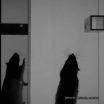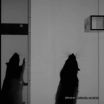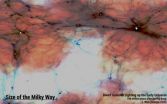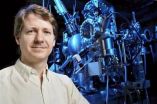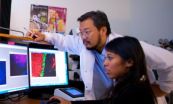(Press-News.org) VIDEO:
This is an example of the use of the whiskers for collision avoidance. Unexpected whisker contact
results in rapid deceleration of forward locomotion velocity and the animal orients to the...
Click here for more information.
The way rats use their whiskers is more similar to how humans use their hands and fingers than previously thought, new research from the University of Sheffield has found.
Rats deliberately change how they sense their environment using their facial whiskers depending on whether the environment is novel, if there is a risk of collision and whether or not they can see where they are going.
Exploring rats move their long facial whiskers back and forth continuously while they are moving – a behaviour called "whisking".
Scientists have known for a long time that movement of the whiskers provides these animals with a sense of touch that allows them to move around easily in the dark.
However, until now they did not know to what extent animals were able to deliberately control their whisker movement.
Academics from the Active Touch Laboratory in the University's Department of Psychology used high-speed videography to study animals that had been trained over several days to run circuits for food.
By putting them in different scenarios – including putting unexpected obstacles in their way and removing visual cues – the team discovered strong evidence the creatures moved their whiskers in a purposeful way to safely navigate the course.
The study found that as animals got used to their environment, they moved quicker and altered their facial whisker movements – switching from broad exploratory whisker sweeps directed at nearby surfaces, such as the floor, to pushing their whisker forwards in order to detect obstacles and avoid collisions.
In environments where they were more likely to collide with objects, and without access to visual cues, animals moved more slowly but pushed their whiskers forward further. This suggests that they were aware on the increased risk of collisions and were acting more cautiously accordingly.
Professor Tony Prescott, Professor of Cognitive Neuroscience at the University of Sheffield, said: "A person moving around in the dark would likely use their hand and fingers to detect objects and obstacles in order to avoid banging into things. In a familiar environment, such as their own home, they might move faster pushing their hands out in front of them in case of unexpected collisions.
"This new research show that rats do much the same thing but using their facial whiskers. That is, they purposefully use their whisker to detect nearby objects and surfaces when moving slowly in unfamiliar environments, and push them out in front of themselves, to avoid collisions, when the environment is familiar and they want to move more quickly.
"All mammals except humans use facial whiskers as touch sensors. In humans we seem to have replaced this sense, in part, by being able to use our hand and fingers to feel our way.
"The rat puts its whiskers where it thinks it will get the most useful information, just as we do with our fingertips."
INFORMATION:
Notes for Editors
The University of Sheffield
With nearly 25,000 of the brightest students from 117 countries coming to learn alongside 1,209 of the world's best academics, it is clear why the University of Sheffield is one of the UK's leading universities. Staff and students at Sheffield are committed to helping discover and understand the causes of things - and propose solutions that have the power to transform the world we live in.
A member of the Russell Group, the University of Sheffield has a reputation for world-class teaching and research excellence across a wide range of disciplines. The University of Sheffield has been named University of the Year in the Times Higher Education Awards 2011 for its exceptional performance in research, teaching, access and business performance.
In 2014 it was voted number one university in the UK for Student Satisfaction by Times Higher Education and in the last decade has won four Queen's Anniversary Prizes in recognition of the outstanding contribution to the United Kingdom's intellectual, economic, cultural and social life.
One of the markers of a leading university is the quality of its alumni and Sheffield boasts five Nobel Prize winners among former staff and students. Its alumni have gone on to hold positions of great responsibility and influence all over the world, making significant contributions in their chosen fields.
Research partners and clients include Boeing, Rolls-Royce, Unilever, Boots, AstraZeneca, GSK, Siemens, Yorkshire Water and many more household names, as well as UK and overseas government agencies and charitable foundations.
For further information, please visit http://www.sheffield.ac.uk
For further information please contact: Hannah Postles, Media Relations Officer, on 0114 222 1046 or email h.postles@sheffield.ac.uk
To read other news releases about the University of Sheffield, visit: http://www.shef.ac.uk/news
Rats purposefully use their whiskers in different ways to help navigate in the dark
2014-07-07
ELSE PRESS RELEASES FROM THIS DATE:
Small, but plentiful: How the faintest galaxies illuminated the early universe
2014-07-07
Light from tiny galaxies over 13 billion years ago played a larger role than previously thought in creating the conditions in the universe as we know it today, a new study has found. Ultraviolet (UV) light from stars in these faint dwarf galaxies helped strip interstellar hydrogen of electrons in a process called reionization.
The epoch of reionization began about 200 million years after the Big Bang and astrophysicists agree that it took about 800 million more for the entire universe to become reionized. It marked the last major phase transition of gas in the universe, ...
NASA satellites see Neoguri grow into a super typhoon
2014-07-07
From July 4 to July 7 Tropical Cyclone Neoguri strengthened from a tropical storm into a supertyphoon. NASA's Terra and Aqua satellites passed over the rapidly intensifying storm and provided forecasters with visible, infrared and microwave data on the powerful supertyphoon.
On July 4 at 0900 UTC (5 a.m. EDT) Neoguri had maximum sustained winds near 55 knots (63.2 mph/101.9 kph). It was located near 13.1 north and 141.4 east, about 207 nautical miles (238.2 miles/383.4 km) west of Andersen Air Force Base, Guam. It was moving to the northwest at 13 knots (14.9 mph/24.0 ...
The new atomic age: Building smaller, greener electronics
2014-07-07
(Edmonton) In the drive to get small, Robert Wolkow and his lab at the University of Alberta are taking giant steps forward.
The digital age has resulted in a succession of smaller, cleaner and less power-hungry technologies since the days the personal computer fit atop a desk, replacing mainframe models that once filled entire rooms. Desktop PCs have since given way to smaller and smaller laptops, smartphones and devices that most of us carry around in our pockets.
But as Wolkow points out, this technological shrinkage can only go so far when using traditional transistor-based ...
Study reveals protective role for specialized cells in intestinal and respiratory systems
2014-07-07
RIVERSIDE, Calif. – Ripping a page from the Star Trek script, specialized cells of the barrier that lines the inside of the intestines and airways of humans have invoked a biological version of Captain Kirk's famous command "shields up" as a first defense against invading microbes.
Research in the UCR School of Medicine laboratory of David Lo found that certain cells of the epithelium have a potentially important role in immune surveillance – creating an electrostatic repulsion field to microbial invasion.
The study is featured on the cover of the July issue of Infection ...
Expectant moms turn to 'Dr. Google' for pregnancy advice
2014-07-07
Pregnant women are using the Internet to seek answers to their medical questions more often than they would like, say Penn State researchers.
"We found that first-time moms were upset that their first prenatal visit did not occur until eight weeks into pregnancy," said Jennifer L. Kraschnewski, assistant professor of medicine and public health sciences, Penn State College of Medicine. "These women reported using Google and other search engines because they had a lot of questions at the beginning of pregnancy, before their first doctor's appointment."
Following the women's ...
Summer McJobs are good for kids, says UBC study
2014-07-07
A new UBC Sauder School of Business study shows that teenagers who work at summer or evening jobs gain a competitive advantage later in life. Developing early knowledge of the working world and how to manage in it, they are more likely to find good employment and earn more money in the future.
"With summer in full swing and kids sitting on the couch, parents are wondering whether to push them to find a job," says Sauder professor Marc-David L. Seidel, who co-authored the study. "Parents may think that their kids could do better than a job at the local fast food joint. ...
For a holistic approach to POW trauma
2014-07-07
The full circumstances of U.S. soldier Bowe Bergdahl's captivity have yet to be revealed. During his tour of duty in Afghanistan in 2009, Bergdahl was captured by the Taliban and held in captivity for five years until a controversial prisoner exchange led to his release on May 31. Bergdahl has been accused of deserting his post and advocating the release of Afghani prisoners.
"We do know that he suffered horrific conditions, tortured and kept in a metal cage in darkness for weeks on end," said Prof. Zahava Solomon, an Israel Prize laureate, Professor of Social Work and ...
Patient patience and pandemics
2014-07-07
Allowing patients to choose which hospital they attend when suffering illness during a pandemic rather than assigning them to a specific healthcare facility is appealing to patients during such a crisis. However, such a patient-centric hospital capacity management is conventionally viewed as inefficient system-wide. According to research published in the International Journal of Mathematics in Operational Research, an incentive-based approach for hospital capacity management can not only accomplish a high efficiency for a concerned hospital system but satisfy patients' ...
World Cup chemistry: The science behind the 'brazuca' (video)
2014-07-07
WASHINGTON, July 7, 2014 — The World Cup final is almost here, and no matter which two teams meet for the title match, there's one thing they'll both need to win: the ball. This week, Reactions examines the chemistry that goes into making the "brazuca," and what makes it different from most other soccer balls out there. The video is available at https://www.youtube.com/watch?v=1XNTfslUzt8.
INFORMATION:
Subscribe to the series at Reactions YouTube, and follow us on Twitter @ACSreactions to be the first to see our latest videos.
The American Chemical Society is a nonprofit ...
Infant toenails reveal in utero exposure to low-level arsenic, Dartmouth study finds
2014-07-07
Infant toenails are a reliable way to estimate arsenic exposure before birth, a Dartmouth College study shows.
The findings appear in the Journal of Exposure Science & Environmental Epidemiology. A PDF of the study is available on request.
A growing body of evidence suggests that in utero and early-life exposure to arsenic may have detrimental effects on children, even at the low to moderate levels common in the United States and elsewhere. The fetus starts to develop toenails during the first trimester, making them an accurate measure of exposure to arsenic during ...
